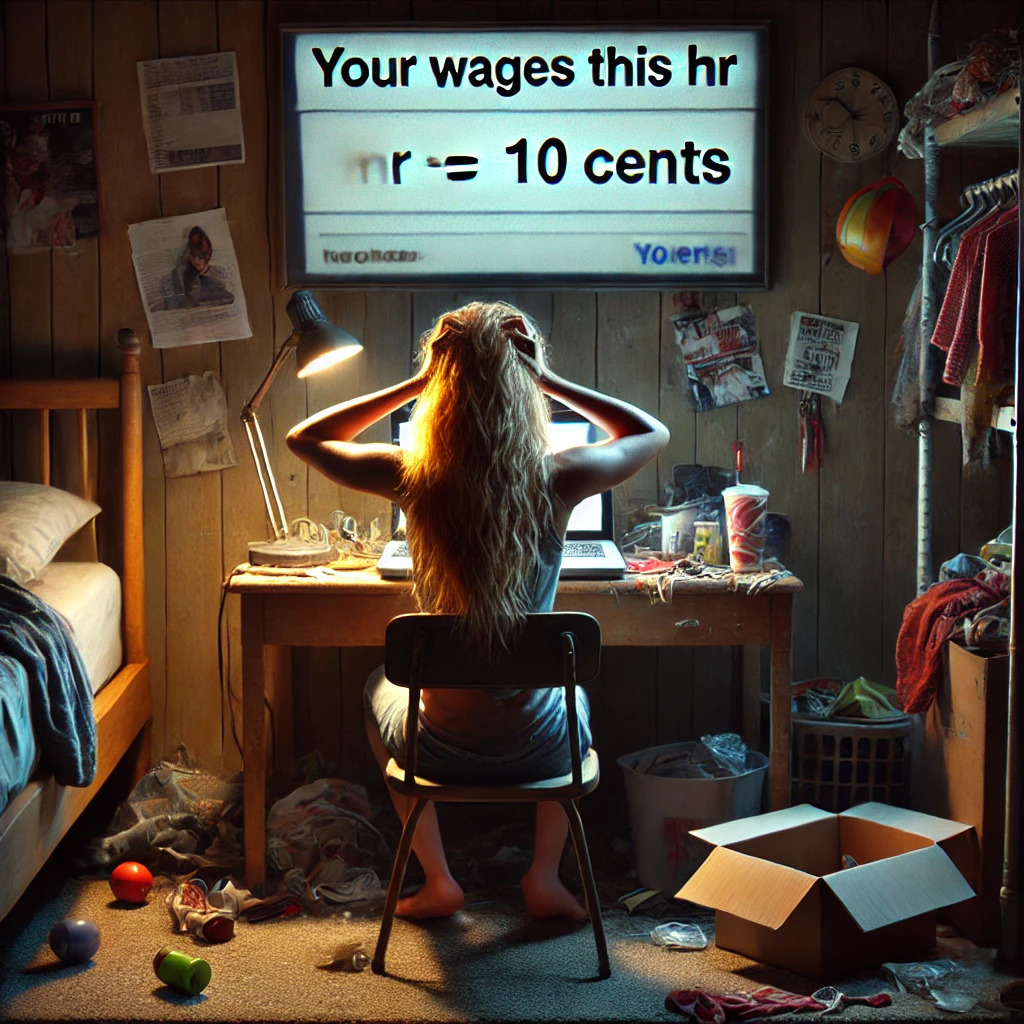The Glittering Facade of AI: A World of Convenience?
Sarah: The Virtual Assistant of 2027
It’s the year 2027, and Sarah, a virtual assistant, manages every aspect of your life. From predicting your needs to executing tasks, Sarah represents the epitome of AI convenience. But beneath this shiny exterior lies a more complex story.
The Illusion of Automation
We are sold the dream that machines like Sarah are working tirelessly for us, making life effortless. However, this illusion of automation is carefully crafted to hide the countless human hands ensuring everything runs smoothly.
The Unseen Workforce: Humans Behind the Machines
Digital Giants’ Dirty Secret
Companies like Google, Facebook, and Amazon boast about their advanced AI systems, but what they don’t tell you is that these technologies heavily rely on a hidden human workforce. These “invisible workers” are the backbone of AI, performing menial tasks for minimal pay.
Disposable and Underpaid: The Reality of AI Trainers
Imagine spending hours labeling images or cleaning up social networks for a few cents per task. This is the harsh reality for AI trainers who are often paid less than minimum wage and treated as disposable assets.
Real Stories: The Plight of AI Workers
Jared, a figure8 worker, earns less than 30 cents an hour, while Dawn, a single mother, struggles to make ends meet despite working full-time on these microtasks. Their stories reflect a growing trend of exploitation in the tech industry.
The Sausage Factory: What They Don’t Want You to See
The Reality of AI Development in Silicon Valley
Silicon Valley is portrayed as a hub of innovation, but behind closed doors, it resembles a factory where human labor is hidden away. The development of AI technologies relies on low-wage workers performing repetitive tasks under challenging conditions.
Figure8: The Human Element in AI Training
Figure8, a company that supplies human-labeled data for machine learning, epitomizes this hidden workforce. Their model depends on an endless loop of humans training machines, which in turn trains more machines—always with humans at the core.
The Endless Loop: Human Labelers and Machine Learning
The process of labeling data is painstaking and repetitive. Workers are required to label thousands of images so that machines can learn to recognize objects. This loop of human-to-machine interaction is endless and often goes unrecognized.
A Global Workforce: Cheap Labor at What Cost?
From San Francisco to Oregon: The Global Reach of AI Labor
The human workforce behind AI is not confined to Silicon Valley. It stretches across the globe, from San Francisco to remote towns in Oregon and beyond, encompassing workers from various backgrounds who take on these tasks for a meager income.
Microtasks, Macro Problems: The Rise of Microwork
The advent of microwork platforms has created a new class of laborers who perform tiny tasks online. While these tasks may seem insignificant, they add up to a colossal human effort, often for less than a living wage.
The Economics of Microwork: A Race to the Bottom
Microwork is a race to the bottom, with companies continuously driving down wages to maximize profits. This business model exploits a global workforce, forcing them to compete for the lowest-paying tasks.
Invisible No More: Bringing the Ghost Workers to Light
Real Lives, Real Stories: Meet the Ghost Workers
These so-called “ghost workers” have remained invisible for too long. People like Jared and Dawn are real individuals with lives, dreams, and struggles. It’s time to shed light on their contributions to the AI industry.
The Human Toll: Mental and Emotional Strain of AI Moderators
Content moderators, another group of invisible workers, are tasked with filtering out the worst of the internet. This work takes a heavy toll on their mental and emotional well-being, often leading to long-term psychological effects.
The Corporate Disconnect: Why Do Tech Leaders Ignore This?
The Stanford-Elite Mindset: A World Apart
The leaders of these tech giants often come from elite backgrounds, educated at institutions like Stanford. This disconnect from the real world allows them to overlook the struggles of the workers who keep their empires running.
The Ethics of AI Labor: A Moral Dilemma
The ethical implications of exploiting a global workforce to train AI cannot be ignored. As the industry grows, so too must our responsibility to protect the rights and dignity of those who make this technology possible.
The Pushback: Legal Actions and Public Outcry
Lawsuits Against Tech Giants: The Fight for Fairness
In recent years, there has been a growing number of lawsuits against tech companies by former workers who were mistreated or underpaid. These legal actions are a crucial step toward holding these corporations accountable.
The Role of International Organizations: A Call for Standards
International organizations like the ILO are beginning to take notice of the exploitation in the AI industry. There is a pressing need for global standards to ensure fair treatment and wages for all workers, regardless of where they are based.
The Future of AI and the Human Cost
What Lies Ahead: Balancing Innovation with Ethics
The future of AI holds immense promise, but it must not come at the expense of human dignity. Balancing innovation with ethics is crucial to ensuring that the progress we make in technology does not leave behind the very people who make it possible.
FAQs
1. What is the invisible workforce behind AI?
The invisible workforce behind AI refers to the millions of workers who perform low-paid, repetitive tasks such as data labeling and content moderation. These tasks are crucial for training AI systems but are often underappreciated and poorly compensated.
2. How do AI companies exploit workers?
AI companies exploit workers by paying them extremely low wages for tasks that are essential to the functioning of AI systems. These workers are often treated as disposable and are denied basic labor rights, such as minimum wage and job security.
3. What are the mental health impacts on AI moderators?
AI moderators, who are tasked with filtering out harmful content on platforms like Facebook, often experience severe mental health impacts. The constant exposure to disturbing and violent material can lead to conditions like post-traumatic stress disorder (PTSD).
4. How are AI workers fighting back?
AI workers are beginning to fight back through legal actions and public outcry. Lawsuits against tech giants are becoming more common, as workers seek fair compensation and better working conditions. Advocacy groups and international organizations are also stepping in to demand higher standards.
5. What can be done to improve the conditions of AI workers?
Improving the conditions of AI workers requires a multi-faceted approach, including stronger labor laws, better wages, and greater transparency from tech companies. International standards and regulations must be implemented to ensure that all workers, regardless of location, are treated fairly.
IF You like our original content, music compositions free for your videos, then join our community!
Together, you can make a difference by making a donation.
Hope to see you with us! Tommy Mac


